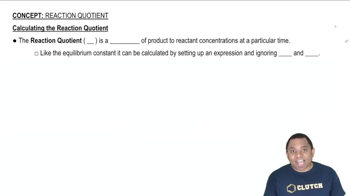Textbook Question
Indicate whether each of the following statements about the reaction quotient Q is true or false: (a) The expression for 𝑄𝑐 looks the same as the expression for 𝐾𝑐.
 Verified step by step guidance
Verified step by step guidance



Indicate whether each of the following statements about the reaction quotient Q is true or false: (a) The expression for 𝑄𝑐 looks the same as the expression for 𝐾𝑐.
At 100°C, the equilibrium constant for the reaction COCl2(𝑔) ⇌ CO(𝑔) + Cl2(𝑔) has the value 𝐾𝑐 = 2.19×10−10. Are the following mixtures of COCl2, CO, and Cl2 at 100°C at equilibrium? If not, indicate the direction that the reaction must proceed to achieve equilibrium.
(a) [COCl2] = 2.00×10−3 M, [CO] = 3.3×10−6 M, [Cl2] = 6.62×10−6 M
(b) [COCl2] = 4.50×10−2 M, [CO] = 1.1×10−7 M, [Cl2] = 2.25×10−6 M
(c) [COCl2] = 0.0100 M, [CO] = [Cl2] = 1.48×10−6 M